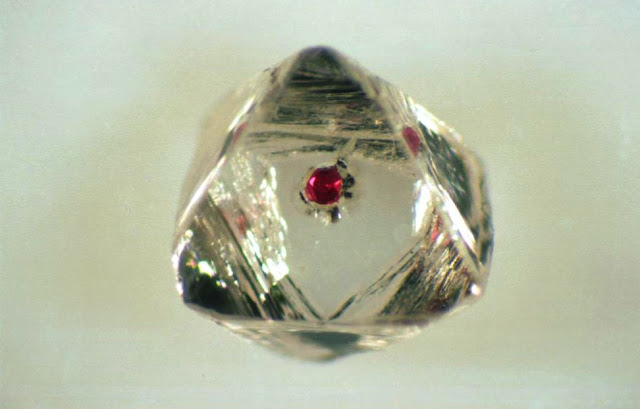Diamonds pinpoint start of colliding continents
 |
| Optical photomicrograph of a sulfide-inclusion-bearing rough diamond from Botswana. |
Jewelers abhor diamond impurities, but they are a bonanza for scientists. Safely encased in the super-hard diamond, impurities are unaltered, ancient minerals that can tell the story of Earth’s distant past. Researchers analyzed data from the literature of over 4,000 of these mineral inclusions to find that continents started the cycle of breaking apart, drifting, and colliding about 3 billion years ago.
Lead author Steven Shirey at the Carnegie Institution’s Department of Terrestrial Magnetism explained: “The Wilson cycle is responsible for the growth of the Earth’s continental crust, the continental structures we see today, the opening and closing of ocean basins through time, mountain building, and the distribution of ores and other materials in the crust. But when it all began has remained elusive until now. We used the impurities, or inclusions, contained in diamonds, because they are perfect time capsules from great depth beneath the continents. They provide age and chemical information for a span of more than 3.5 billion years that includes the evolution of the atmosphere, the growth of the continental crust, and the beginning of plate tectonics.”
Coauthor and longtime colleague Stephen Richardson of the University of Cape Town added: “It is astonishing that we can use the smallest mineral grains that can be analyzed to reveal the origin of some of Earth’s largest geological features.”
The largest diamonds come from cratons, the most ancient formations within continental interiors that have deep mantle roots or keels around which younger continental material gathered. Cratons contain the oldest rocks on the planet, and their keels extend into the mantle more than 125 miles (200 km) where pressures are sufficiently high, but temperatures sufficiently low, for diamonds to form and be stored for billions of years. The diamonds arrived at the surface as accidental passengers during volcanic eruptions of deep magma that solidified into rocks called kimberlites. The inclusions in diamonds come in two major varieties: peridotitic and eclogitic. Peridotite is the most abundant rock type in the upper mantle, whereas eclogite is generally thought to be the remnant of oceanic crust recycled into the mantle by the subduction or sinking of tectonic plates.
Shirey and Richardson, using their own work with other coinvestigators published in more than 20 papers over a 25-year period, reviewed the data from more than 4,000 inclusions of silicate — Earth’s most abundant material — and more than 100 inclusions of sulfide from five ancient continents. The most crucial aspects were to look at when the inclusions were encapsulated and the associated compositional trends. Compositions vary and depend on the geochemical processing that precursor components underwent before they were encapsulated.
Two systems used to date inclusions — the rhenium-osmium and samarium-neodymium techniques — were compared. Both rely on natural isotopes that decay at exceedingly slow but predictable rates — around one disintegration every ten years on the scale of an inclusion — making them excellent atomic clocks for determining absolute ages.
The researchers found that before 3.2 billion years ago, only diamonds with peridotitic compositions formed — whereas subsequent to 3 billion years ago, eclogitic diamonds dominated. “The simplest explanation is that this change came from the initial subduction of one tectonic plate under the deep mantle keel of another as continents began to collide on a scale similar to that of the supercontinent cycle today. The sequence of underthrusting and collision led to the capture of eclogite in the subcontinental mantle keel along with the fluids that are needed to make diamonds.” remarked Shirey. “This transition marks the onset of the Wilson cycle of plate tectonics,” concluded Richardson.
Materials provided by Carnegie Institution.